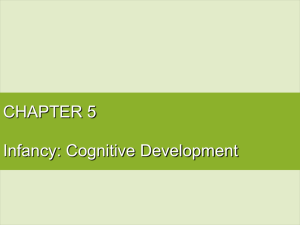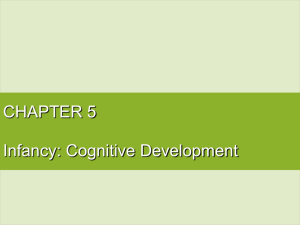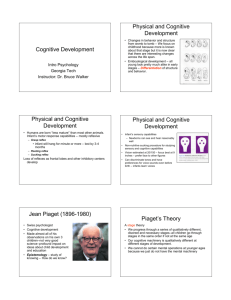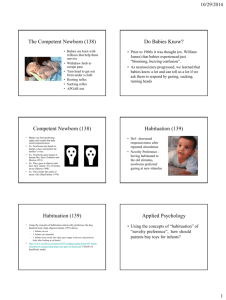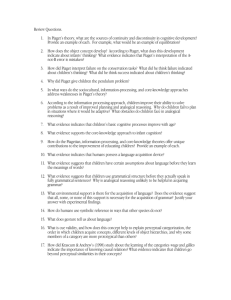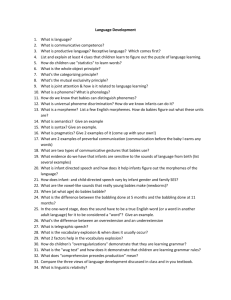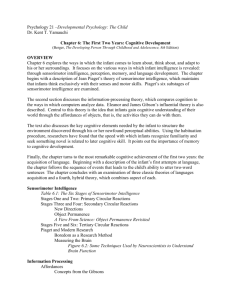Cognitive Development Chapter Outline: Approaches & Stages
advertisement
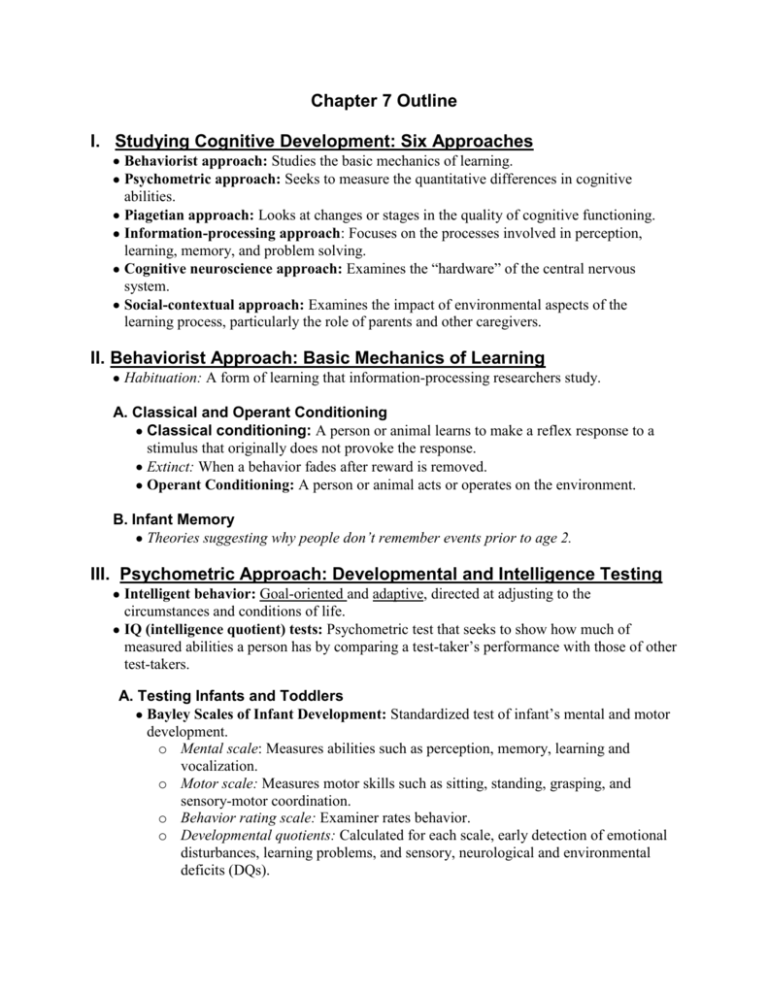
Chapter 7 Outline I. Studying Cognitive Development: Six Approaches Behaviorist approach: Studies the basic mechanics of learning. Psychometric approach: Seeks to measure the quantitative differences in cognitive abilities. Piagetian approach: Looks at changes or stages in the quality of cognitive functioning. Information-processing approach: Focuses on the processes involved in perception, learning, memory, and problem solving. Cognitive neuroscience approach: Examines the “hardware” of the central nervous system. Social-contextual approach: Examines the impact of environmental aspects of the learning process, particularly the role of parents and other caregivers. II. Behaviorist Approach: Basic Mechanics of Learning Habituation: A form of learning that information-processing researchers study. A. Classical and Operant Conditioning Classical conditioning: A person or animal learns to make a reflex response to a stimulus that originally does not provoke the response. Extinct: When a behavior fades after reward is removed. Operant Conditioning: A person or animal acts or operates on the environment. B. Infant Memory Theories suggesting why people don’t remember events prior to age 2. III. Psychometric Approach: Developmental and Intelligence Testing Intelligent behavior: Goal-oriented and adaptive, directed at adjusting to the circumstances and conditions of life. IQ (intelligence quotient) tests: Psychometric test that seeks to show how much of measured abilities a person has by comparing a test-taker’s performance with those of other test-takers. A. Testing Infants and Toddlers Bayley Scales of Infant Development: Standardized test of infant’s mental and motor development. o Mental scale: Measures abilities such as perception, memory, learning and vocalization. o Motor scale: Measures motor skills such as sitting, standing, grasping, and sensory-motor coordination. o Behavior rating scale: Examiner rates behavior. o Developmental quotients: Calculated for each scale, early detection of emotional disturbances, learning problems, and sensory, neurological and environmental deficits (DQs). B. Assessing the Impact of the Home Environment Home Observation for Measurement of the Environment (HOME): Instrument to measure the influence of the home environment on children’s cognitive growth. D. Early Intervention Early Intervention: Systematic process of planning and providing therapeutic and educational services to families to help meet young children’s developmental needs. IV. Piagetian Approach: The Sensorimotor Stage Sensorimotor Stage: In Piaget’s theory, the first stage in cognitive development, from birth to 2 years, during which infants learn through sensory and motor activity. A. Substages of the Sensorimotor Stage Schemes: Piaget’s term for organized patterns of behavior used in particular situations. Circular reactions: Piaget’s term for processes by which an infant learns to reproduce desired occurrences originally discovered by chance. First substage (birth to about 1 month): Neonates begin to exercise some control over their inborn reflexes. Second substage (about 1 to 4 months): Babies learn to repeat a pleasant bodily sensation first achieved by chance. Piaget’s Primary circular reactions. Third substage (about 4 to 8 months): Babies engage in Secondary circular reactions; intentional actions repeated not merely for their own sake, but to get results beyond the infant’s own body. Fourth substage, coordination of secondary substages about (8 to 12 months): Infants learn to generalize from past experience to solve new problems and to distinguish means from ends. Fifth substage (about 12 to 18 months): Babies begin to experiment with new behaviors to see what will happen. They now engage in Tertiary circular reactions, varying an action to get a similar result rather than just repeating pleasing behavior that they have accidentially discovered. Sixth substage, mental combinations (about 18 months to 2 years): Transition into the preoperational stage of early childhood. Representational ability: Piaget’s term for the capacity to mentally represent objects and experiences, largely through the use of symbols such as words, numbers and mental pictures. B. Do Imitative Abilities Develop Earlier Than Piaget Thought? Invisible imitation: Imitation using parts of the body the baby cannot see. Visible imitation: Imitation using parts of the body the baby can see. Deferred imitation: Repeating actions they no longer see in front of them. Elicited imitation: Researchers induce infants and toddlers to imitate a specific series of actions they have seen but not necessarily done before. Pretend play: Also called fantasy or dramatic play which uses representational abilities. C. Development of Knowledge about Objects and Space Object concept: The idea that objects have their own independent existence, characteristics, and location in space; fundamental to an orderly view of physical reality. D. When Does Object Permanence Develop? Object permanence: Piaget’s term for the realization that a person or object still exists when out of sight. A, not-B error: Tendency for 8 to 12 month old infants to search for a hidden object in a place where they previously found it rather than in the place where they most recently saw it being hidden. E. Symbolic Development, Pictorial Competence, and Understanding of Scale Symbols: Intentional representations of reality. Symbol-minded: Attentive to symbols and their relationship to the things they represent. Pictorial competence: The ability to understand the nature of pictures. Scale errors: Momentary misperception of the relative sizes of objects. Dual representation hypothesis: Child has to mentally represent both the symbol and its relationship to the thing it stands for at the same time. F. Evaluating Piaget’s Sensorimotor Stage 1. Information-Processing Approach: Perceptions and Representations G. Habituation Habituation: A type of learning in which repeated or continuous exposure to a stimulus reduces attention to that stimulus. Dishabituation: Increased attention to a new stimulus. H. Visual and Auditory Processing Abilities Visual preference: Tendency of infants to spend more time looking at one sight than another; an indication of an ability to make visual distinctions. Visual recognition memory: Ability to distinguish a familiar visual stimulus from a novel one when shown both at the same time. Cross-modal transfer: Ability to use information gained by one sense to guide another. Joint attention: (joint perceptual exploration) When babies respond to adult’s gaze by looking or pointing in the same direction. I. Information Processing as a Predictor of Intelligence Visual expectation paradigm: Computerized measurements of visual reaction time and visual anticipation are used to measure attentiveness and processing speed as well as the tendency to form expectations on the basis of experience. J. Information Processing and the Development of Piagetian Abilities 1. Categorization Categorization: The ability to group things into categories based on shared characteristics. 2. Causality Causality: The principle that one event causes another. 3. Object permanence Violations-of–expectations: Research method in which dishabituation to a stimulus that conflicts with previous experience is taken as evidence that an infant recognizes the new stimulus as surprising. 4. Number 5. Evaluating Information Processing Research on Infants Innate learning mechanisms: Reasoning abilities infants are born with or acquire very early. Core knowledge: Intuitive knowledge of basic physical principles that help infants organize perceptions and observations. Violation-of-expectations studies: May reveal a conceptual understanding of the way things work or merely a perceptual awareness that something unusual has happened. a. Cognitive Neuroscience Approach: The Brain’s Cognitive Structures Implicit memory: Memory that occurs without effort or conscious awareness such as habits or skills. Explicit memory: (Declarative memory) Memory that is an intentional and conscious recollections of facts, names or events. Prefrontal cortex: The large portion of the frontal lobe directly behind the forehead. Working memory: Short-term storage of information which is being actively processed. b. Social-Context Approach: Learning from Interactions with Caregivers Guided participation: Mutual interactions with adults that help structure children’s activities and bridge the gap between the children’s understanding and the adult’s. V. Language Development Language: Communication system based on words, grammar and cognitive development. A. Sequence of Early Language Development Prelinguistic speech: Forerunner of linguistic speech; utterance of sounds that are not words. Includes crying, cooing, babbling, and accidental and deliberate imitation of sounds without understanding their meaning. 1. Early Vocalization Crying: Newborn’s only means of communication. Cooing: Sounds made between 6 weeks and 3 months when babies are happy. Babbling: Repeating consonant-vowel strings. Imitation of language sounds: Infants deliberately imitate sounds without understanding them. 2. Perceiving Language Sounds and Structure Neural commitment: Ongoing process of pattern perception and categorization seems to commit the brain’s neural networks to further learning of similar patterns. Phonemes: Basic sounds. 3. Gestures Conventional social gestures (between 9 and 12 months): Waving bye-bye, nodding yes, and shaking head no. Representational gestures (about 13 months): Using gestures to indicate need or want. Symbolic gestures (about 12 to 14 months): Using gestures to refer to specific objects, events, desires or conditions. 4. First Words Linguistic speech: Verbal expression designed to convey meaning. Holophrase: Single word that conveys a complete thought. Passive vocabulary: Receptive or understood vocabulary. Expressive vocabulary: Spoken vocabulary. 5. First Sentences Telegraphic speech: Early form of sentence consisting of only a few essential words. Syntax: Rules for forming sentences in a particular language. B. Characteristics of Early Speech 1. Children Simplify: Use telegraphic speech to say just enough to get their meaning across. Understand grammatical relationships they cannot yet express. Underextend word meanings: Restricting the use of a word to a single object. Overextend word meanings: Overgeneralizing word meanings. Overregularize rules: Apply them rigidly, not knowing that some rules have exceptions. C. Classic Theories of Language Acquisition: The Nature-Nurture Debate Nativism (Chomsky): Theory that human beings have an innate capacity for language acquisition. Language acquisition device (LAD): In Chomsky’s terminology, an inborn mechanism that programs children’s brains to infer linguistic rules that form the language they hear. Hand-babbling: Deaf babies first string together meaningless motions and repeat them over and over. D. Influences on Language Development 1. Brain Development Brain stem and pons: Primitive parts of brain that are the earliest to develop. Motor cortex: Controls movement of the face and larynx; maturation enables language. 2. Social Interaction: The Role of Parents and Caregivers a. Prelinguistic Period Prelinguistic period: Repeating sounds the baby makes; social exchange. b. Vocabulary Development Code mixing: Use of elements of two languages, sometimes in the same utterance, by young children in households where both languages are spoken. Code switching: Process of changing one’s speech to match the situation, as in people who are bilingual. 3. Child-Directed Speech Child-directed speech (CDS): Form of speech often used in talking to babies or toddlers; includes slow, simplified speech, a high-pitched tone, exaggerated vowel sounds, short words and sentences, and much repetition. Also called parentese. 4. Deaf Children and Language Development Classic theories and how they explain language acquisition in deaf children Inventing Sign Language E. Preparing for Literacy: The Benefits of Reading Aloud Literacy: The abilities to read and write. 1. Adult reading styles Describer style: Describes what is going on in the pictures and invites the child to also do so. Comprehender style: Encourages child to look more deeply at the meaning of a story and make inferences and predictions. Performance-oriented style: Reads the story straight through, introducing the main themes beforehand and asking questions afterward. Dialogic reading: Shared reading; the child learns to be the storyteller while the adult acts as the active listener.

